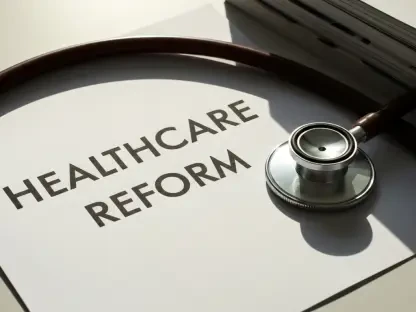In an era where healthcare is increasingly digital, imagine a patient struggling to gather medical records from multiple providers, juggling different portals, and facing delays in sharing critical information with a specialist. This frustrating scenario is all too common, underscoring a pressing need for seamless access to health data. The healthcare technology sector stands at a pivotal moment, with innovations promising to bridge these gaps and empower patients. A key player in this transformation is HealthEx, whose groundbreaking platform leverages the Trusted Exchange Framework and Common Agreement (TEFCA) to redefine how individuals interact with their medical information. This report explores the current landscape of patient data access, HealthEx’s innovative contributions, and the broader implications for interoperability in healthcare.
Understanding the Healthcare Data Access Landscape
The healthcare technology sector is undergoing a profound shift, driven by the urgent demand for better access to patient data. Fragmentation remains a significant barrier, as medical records are often scattered across various providers, hospitals, and electronic health record (EHR) systems. Patients frequently encounter cumbersome processes, such as managing multiple logins or manually coordinating information, which can hinder timely care. This disjointed system not only frustrates individuals but also poses risks to health outcomes when critical data is unavailable during emergencies or transitions of care.
Seamless access to health information holds immense importance for both patients and providers. It empowers individuals to take an active role in managing their health, facilitates better coordination among care teams, and ultimately contributes to improved clinical results. When patients can easily retrieve and share their records, it reduces redundancies in testing and enhances decision-making. Amid rising healthcare costs and complex chronic conditions, the ability to access comprehensive data in real time is no longer a luxury but a necessity for effective care delivery.
The industry features a mix of established players and tech giants pushing for interoperability. Organizations like HealthEx, CLEAR, athenahealth, MedAllies, and CommonWell Health Alliance are at the forefront, alongside major technology companies such as Amazon, Apple, and Google, which are investing heavily in digital health solutions. Regulatory frameworks like TEFCA, supported by federal policies, and advancements in digital tools and third-party applications are shaping the sector. These technological and policy influences are setting the stage for a more connected healthcare ecosystem, though significant challenges in integration and adoption persist.
HealthEx’s Innovative Platform: A Game-Changer for Patient Empowerment
Core Features and Benefits of HealthEx’s Platform
HealthEx has introduced a transformative platform that functions as a digital wallet for health records, offering patients unprecedented access to their medical information. This system enables real-time viewing and sharing of comprehensive data, streamlining what was once a tedious process. By consolidating records from disparate sources into a single, user-friendly interface, the platform eliminates the need for patients to navigate multiple systems, ensuring they have vital information at their fingertips whenever needed.
A cornerstone of this solution is its emphasis on patient control and consent. HealthEx prioritizes empowerment by allowing individuals to decide who can access their data and under what conditions, with transparent audit trails providing visibility into every interaction. This focus on autonomy addresses long-standing concerns about privacy in digital health, building trust among users. Such features are especially valuable in an environment where data breaches and misuse remain top concerns for many.
The platform’s initial release targets payers, providers, and digital health companies, positioning it as a vital tool for early adopters in the industry. Its impact is expected to be particularly significant in underserved ambulatory settings, where limited IT resources often hinder data sharing. By bridging these gaps, HealthEx not only enhances care coordination for smaller practices but also paves the way for broader health equity, ensuring that more patients benefit from connected care regardless of their location or provider’s capabilities.
Collaborative Efforts and Industry Partnerships
Achieving this level of innovation required extensive collaboration across the healthcare technology spectrum. HealthEx partnered with CLEAR to integrate secure identity verification, ensuring that access to sensitive data meets high security standards. Additionally, collaborations with athenahealth enabled robust EHR integration, while MedAllies and CommonWell, as TEFCA Qualified Health Information Networks (QHINs), facilitated cross-network data exchange, creating a cohesive framework for interoperability.
Overcoming technical barriers was no small feat, with nearly two years of dedicated effort to harmonize identity verification, consent management, and data retrieval across QHINs. These challenges included ensuring that disparate systems could communicate effectively while maintaining a seamless user experience. The result is a platform that simplifies complex processes behind the scenes, allowing patients to authenticate once and access records without repetitive hurdles, setting a new standard for ease of use.
Industry projections highlight the potential scale of this initiative, with leaders anticipating a surge in transaction volumes for individual access. Estimates suggest that within a year from now, daily transactions could reach millions, reflecting rapid adoption and growing demand. This growth trajectory underscores the market’s readiness for solutions like HealthEx’s platform and signals a shift toward consumer-directed data exchange as a core component of modern healthcare delivery.
Challenges in Achieving Seamless Data Exchange
The path to revolutionizing patient data access is fraught with obstacles, even for pioneering platforms like HealthEx. Technical complexities pose a significant challenge, as integrating disparate EHR systems and ensuring smooth data flow across networks requires intricate coordination. Maintaining a user-friendly interface while managing these backend intricacies adds another layer of difficulty, as any glitch or delay can erode patient trust and hinder adoption.
Scalability and widespread adoption present additional hurdles, particularly when expanding solutions across diverse EHR vendors and Individual Access Services (IAS) providers. The diversity in technology infrastructure and varying levels of readiness among stakeholders mean that full implementation will take time. Smaller providers, in particular, may struggle with the resources needed to integrate new systems, slowing the pace of broader rollout and necessitating tailored support to ensure inclusivity.
Addressing these issues demands innovative strategies and sustained effort. Cross-industry collaboration, as demonstrated by HealthEx’s partnerships, is essential for standardizing processes and overcoming silos. Building on the foundational work of TEFCA provides a structured approach to interoperability, while continuous advancements in technology offer hope for simplifying integration. These combined efforts aim to create a robust ecosystem where data exchange becomes a seamless part of healthcare delivery, regardless of system or setting.
The Role of TEFCA and Regulatory Frameworks
TEFCA, established under the 21st Century Cures Act and overseen by the Office of the National Coordinator for Health Information Technology (ONC), serves as a critical backbone for nationwide data exchange. It provides a standardized framework through which health information networks can connect, ensuring secure and scalable interoperability. With thousands of organizations already participating, TEFCA is rapidly becoming the gold standard for facilitating data sharing across the industry.
Compliance with TEFCA involves stringent security and privacy standards, such as HITRUST certification, to protect patient information from unauthorized access. Beyond these requirements, additional safeguards are in place to address evolving threats in the digital health space. These measures are crucial for maintaining public confidence, especially as more personal data is shared through third-party applications and consumer-facing tools outside traditional regulatory oversight like HIPAA.
HealthEx’s alignment with TEFCA supports broader federal objectives, particularly the Centers for Medicare & Medicaid Services (CMS) vision for a patient-centric healthcare system. Recent commitments from 60 leading healthcare technology organizations to advance interoperability by 2027 further reinforce this direction. By adhering to these goals, HealthEx not only complies with regulatory expectations but also positions itself as a leader in shaping a future where patients are at the center of data-driven care.
Future Outlook: Transforming Healthcare Through Interoperability
Looking ahead, the healthcare industry is poised for significant transformation through emerging technologies and innovations. AI-driven health agents and personalized digital tools are on the horizon, enabled by platforms like HealthEx that provide the necessary data infrastructure. These advancements promise to deliver tailored health services, from medication reminders to predictive analytics, enhancing both patient engagement and clinical efficiency in ways previously unimaginable.
Market growth is fueled by a rising demand for consumer-directed data exchange, reflecting a shift toward patient-centric models of care. As individuals increasingly expect control over their health information, similar to how they manage financial or personal data, solutions that prioritize ease of access and transparency will likely dominate. This trend aligns with evolving consumer preferences for digital solutions that integrate seamlessly into daily life, driving adoption of interoperable platforms across diverse demographics.
Regulatory developments and global interoperability efforts will continue to influence the sector’s trajectory. Economic conditions and policy priorities may shape the pace of investment and implementation, while international initiatives to standardize data exchange could inspire further collaboration. Together, these factors suggest a dynamic landscape where sustained focus on security, scalability, and innovation will be essential for realizing the full potential of connected healthcare systems worldwide.
Final Thoughts on HealthEx’s Impact
Reflecting on the insights gathered, it is evident that HealthEx has carved a significant path in the realm of patient data access through its alignment with TEFCA and strategic industry partnerships. The platform has tackled long-standing issues of fragmentation, offering a glimpse into a future where patients can effortlessly manage their health records. Its emphasis on consent and transparency has set a benchmark for trust in digital health tools, while its focus on underserved settings highlights a commitment to equity.
Moving forward, stakeholders should prioritize actionable steps to build on this momentum. Strengthening privacy protections through ongoing updates to security protocols will be critical as data sharing expands. Additionally, investing in scalable infrastructure to support smaller providers can accelerate adoption, ensuring no segment of the healthcare ecosystem is left behind. Finally, fostering innovation in AI and personalized health solutions should remain a key focus, as these technologies hold the promise of transforming raw data into meaningful, life-changing outcomes for patients everywhere.









